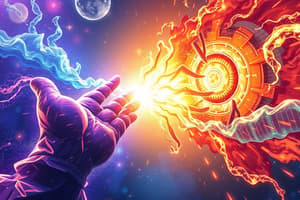Podcast
Questions and Answers
What is the unit of kinetic energy?
What is the unit of kinetic energy?
- Kilogram per second (kg/s)
- Newton (N)
- Joule (J) (correct)
- Meter per second (m/s)
What happens to kinetic energy when an object moves faster?
What happens to kinetic energy when an object moves faster?
- It becomes zero
- It remains the same
- It decreases
- It increases (correct)
What is the process of changing energy from one form to another?
What is the process of changing energy from one form to another?
- Energy transformation
- Energy conservation
- Energy conversion (correct)
- Energy transfer
What type of energy conversion occurs when a car engine converts chemical energy from fuel to mechanical energy?
What type of energy conversion occurs when a car engine converts chemical energy from fuel to mechanical energy?
What is the energy an object has due to its position or configuration?
What is the energy an object has due to its position or configuration?
What is the formula for gravitational potential energy?
What is the formula for gravitational potential energy?
What happens to potential energy when an object falls or is released?
What happens to potential energy when an object falls or is released?
What is an example of elastic potential energy?
What is an example of elastic potential energy?
What is the law of energy conservation?
What is the law of energy conservation?
What is the difference between kinetic energy and potential energy?
What is the difference between kinetic energy and potential energy?
Study Notes
Kinetic Energy
- Definition: The energy of motion, associated with an object's motion.
- Formula: K = (1/2)mv^2, where K is kinetic energy, m is mass, and v is velocity.
- Units: Joules (J)
- Characteristics:
- Depends on the square of the velocity.
- Increases as the object moves faster.
- Can be transferred from one object to another through collisions.
Energy Conversion
- Definition: The process of changing energy from one form to another.
- Types:
- Mechanical Energy Conversion: Conversion between kinetic energy and potential energy.
- Thermal Energy Conversion: Conversion between thermal energy and other forms of energy.
- Electromagnetic Energy Conversion: Conversion between electromagnetic energy and other forms of energy.
- Law of Energy Conservation: Energy cannot be created or destroyed, only converted from one form to another.
- Examples:
- A rolling ball converts kinetic energy to potential energy as it climbs a hill.
- A car engine converts chemical energy from fuel to mechanical energy.
Potential Energy
- Definition: The energy an object has due to its position or configuration.
- Types:
- Gravitational Potential Energy: Energy due to an object's height or position in a gravitational field.
- Elastic Potential Energy: Energy stored in stretched or compressed materials, such as springs or rubber bands.
- Electrical Potential Energy: Energy due to an object's electric charge or position in an electric field.
- Formula: U = mgh, where U is potential energy, m is mass, g is gravitational acceleration, and h is height.
- Characteristics:
- Can be converted to kinetic energy when the object falls or is released.
- Depends on the object's position or configuration.
Kinetic Energy
- Kinetic energy is the energy of motion, associated with an object's motion.
- The formula to calculate kinetic energy is K = (1/2)mv^2, where K is kinetic energy, m is mass, and v is velocity.
- Kinetic energy is measured in Joules (J).
- The characteristics of kinetic energy are:
- It depends on the square of the velocity.
- It increases as the object moves faster.
- It can be transferred from one object to another through collisions.
Energy Conversion
- Energy conversion is the process of changing energy from one form to another.
- There are three types of energy conversion: mechanical energy conversion, thermal energy conversion, and electromagnetic energy conversion.
- The Law of Energy Conservation states that energy cannot be created or destroyed, only converted from one form to another.
- Examples of energy conversion include:
- A rolling ball converting kinetic energy to potential energy as it climbs a hill.
- A car engine converting chemical energy from fuel to mechanical energy.
Potential Energy
- Potential energy is the energy an object has due to its position or configuration.
- There are three types of potential energy: gravitational potential energy, elastic potential energy, and electrical potential energy.
- The formula to calculate gravitational potential energy is U = mgh, where U is potential energy, m is mass, g is gravitational acceleration, and h is height.
- The characteristics of potential energy are:
- It can be converted to kinetic energy when the object falls or is released.
- It depends on the object's position or configuration.
Studying That Suits You
Use AI to generate personalized quizzes and flashcards to suit your learning preferences.
Description
Learn about kinetic energy, its definition, formula, and characteristics. Also, understand the process of energy conversion from one form to another.




